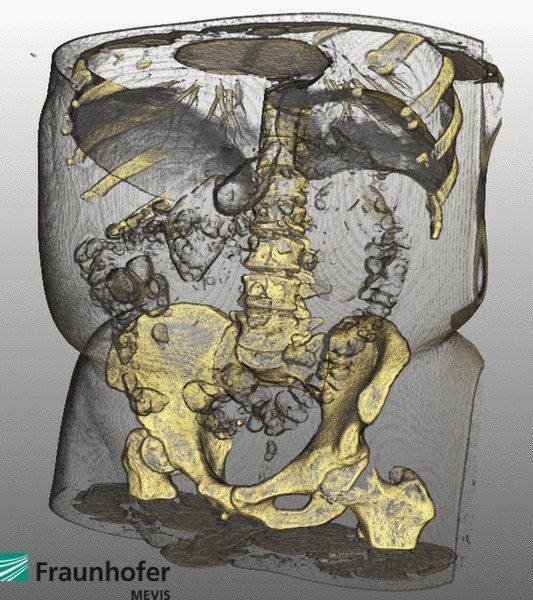 | ||
Initial release 1993; 24 years ago (1993) Stable release 2.8.1 / June 21, 2016; 8 months ago (2016-06-21) Operating system Type Image processing, scientific visualization, medical imaging, volume rendering | ||
MeVisLab is a cross-platform application framework for medical image processing and scientific visualization. It includes advanced algorithms for image registration, segmentation, and quantitative morphological and functional image analysis. An IDE for graphical programming and rapid user interface prototyping is available.
Contents
- History
- Features
- MeVisLab principles
- MeVisLab forum
- Release history
- Fields of application research projects
- Licensing
- MeVisLab public sources
- MeVisLab community and community sources
- PythonQt
- Similar software projects
- References
MeVisLab is written in C++ and uses the Qt framework for graphical user interfaces. It is available cross-platform on Windows, Linux, and Mac OS X. The software development is done in cooperation between MeVis Medical Solutions AG and Fraunhofer MEVIS.
A freeware version of the MeVislab SDK is available (see Licensing). Open source modules are delivered as MeVisLab Public Sources in the SDK and available from the MeVisLab Community and Community Sources project.
History
MeVisLab development began in 1993 with the software ILAB1 of the CeVis Institute, written in C++. It allowed to interactively connect algorithms of the Image Vision Library (IL) on Silicon Graphics (SGI) to form image processing networks. In 1995, the newly founded MeVis Research GmbH (which became Fraunhofer MEVIS in 2009) took over the ILAB development and released ILAB2 and ILAB3. OpenInventor and Tcl scripting was integrated but both programs were still running on SGI only.
In 2000, ILAB4 was released with the core rewritten in Objective-C for Windows. For being able to move away from the SGI platform, the Image Vision Library was substituted by the platform-independent, inhouse-developed MeVis Image Processing Library (ML). In 2002, the code was adapted to work on the application framework Qt.
In 2004, the software was released under the name MeVisLab. It contained an improved IDE and was available on Windows and Linux. See the Release history for details.
In 2007, MeVisLab has been acquired by MeVis Medical Solutions AG. Since then, MeVisLab has been continued as a collaborative project between the MeVis Medical Solutions and Fraunhofer MEVIS.
Features
MeVisLab features include:
MeVisLab principles
MeVisLab is a modular development framework. Based on modules, networks can be created and applications can be built.
To support the creation of image processing networks, MeVisLab offers an IDE that allows data-flow modelling by visual programming. Important IDE features are the multiple document interface (MDI), module and connection inspectors with docking ability, advanced search, scripting and debugging consoles, movie and screenshot generation and galleries, module testing and error handling support.
In the visual network editor, modules can be added and combined to set up data flow and parameter synchronization. The resulting networks can be modified dynamically by scripts at runtime. Macro modules can be created to encapsulate subnetworks of modules, scripting functionality and high-level algorithms.
On top of the networks, the medical application level with viewers and UI panels can be added. Panels are written in the MeVisLab Definition Language (MDL), can be scripted with Python or JavaScript and styled using MeVisLab-internal mechanisms or Qt features.
The development of own modules written in C++ or Python is supported by wizards.
MeVisLab forum
MeVisLab offers a very well-supported public forum in which core developers as well as users of all levels of experience share information. A free registration is necessary.
Release history
The table below lists all main releases, without release candidates and maintenance releases. Various larger changes were made from version 1.6 to version 2.0. For detailed changes in the ML, see the ML Release Notes. For release news, see Release News on the MeVisLab Homepage.
Fields of application, research projects
MeVisLab has been used in a wide range of medical and clinical applications, including surgery planning for liver, lung, head and neck and other body regions, analysis of dynamic, contrast enhanced breast and Prostate MRI, quantitative analysis of neurologic and cardiovascular image series, orthopedic quantification and visualization, tumor lesion volumetry and therapy monitoring, enhanced visualization of mammograms, 3D breast ultrasound and tomosynthesis image data, and many other applications. MeVisLab is also used as a training and teaching tool for image processing (both general and medical) and visualization techniques.
MeVisLab is and has been used in many research projects, including:
Based on MeVisLab, the MedicalExplorationToolkit was developed to improve application development. It is available as AddOn package for MeVisLab 1.5.2. and 1.6 on Windows.
MeVisLab can also be used to generate surface models of biomedical images and to export them in Universal 3D format for embedding in PDF files.
Licensing
The MeVisLab SDK can be downloaded at no cost and without prior registration. The software can be used under three different license models:
None of the above license models permits the redistribution of the MeVisLab SDK or parts thereof, or using MeVisLab or parts thereof as part of a commercial service or product.
The Fraunhofer MEVIS Release Modules are intellectual property of Fraunhofer MEVIS and strictly for non-commercial purposes.
MeVisLab public sources
As of MeVisLab 1.3, selected MeVisLab Standard modules are open source and available as MeVisLab Public Sources. As of MeVisLab 2.0, these public sources are fully integrated in the MeVisLab SDK.
The source code is released under BSD license.
MeVisLab community and community sources
In the MeVisLab Community Project, open-source modules for MeVisLab are contributed by a number of institutions. Contributors as of 2010 are:
The source code is released under BSD or LGPL license and managed in a central repository on SourceForge. Continuous builds are offered for various platforms.
PythonQt
PythonQt is a Python script binding for the Qt framework. It was originally written to make MeVisLab scriptable and then published as open source in 2007 under LGPL. An introduction of PythonQt was published in Qt Quarterly, which also includes a comparison to Pyqt.
PythonQt sources and documentation are available from SourceForge.
